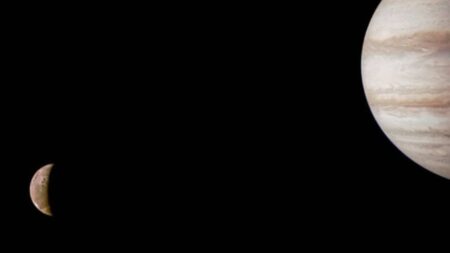The new moon this month is on 6th September (Monday). It is considered that for the next two days the Venus and Mercury will make a close pass.
After the sunset on 5th September, one can notice a trio of really bright lights, specifically on the western part of the horizon.
These bright lights are not to be misunderstood as stars, Mercury, Venus, and one of the brightest stars called Spica will be visible to people on Earth.
The weather plays an important role, and a clear sky will make it easier to get a clear view of both these planets.
Spica is often referred to as a close double star. It is precisely 262 lightyears away from Earth and in the Virgo the Maiden constellation. Spica may have more than two stars; however, it looks like there are two stars in there.
The star seems bluish-white in colour and looks lone in the sky. This pair of stars is way hotter when compared to the Sun, and they are close to 11 million miles away from each other.
They take four days in total to orbit the centre of gravity that is common to both of them. When seen from Earth, these two stars can be individually distinguished.
On 7th September, the new moon starts at 8:52 pm. It is the time when the moon is directly in between the Earth and the Sun.
The Sun, Earth and the Moon share a similar celestial longitude which is often technically referred to as conjunction.
One can spot this trio tonight, and the brightest star seen from Earth will be Spica. There can be a slight confusion between Venus and Spica; however, Spica will join the Virgo constellation later in the night.
On Sunday, Venus was seen shining about a width of a thumb higher than Spica. These stars were visible with low power telescopes and binoculars as a red circle.
It is advisable to look for the stars after 8 pm. It is further advisable to wait for the Sun to set completely before using the binoculars and telescopes. Right after the sunset, Venus will be visible; however, for Spica to be visible the sky needs to get a little darker.
It is the last month of monsoon in the southwest, and hence it can be expected that the sky will be clouded. This spectacle of view will be there till 12th September, and one can catch a sight of these stars on any of these days.
As per NASA, on a darker night, the Milky Way galaxy can be seen in most parts of Earth. Here is the list of all the sky events that will occur in the month of September.
5th September
Venus and Spica will be really close to each other.
6th September
Mercury will be at the farthest distance from the planet.
7th to 13th September
The new moon occurs on the 7th of the month, and the moon will approach its first quarter by the 13th of the month.
14th September
Mars will appear as if it is touching the horizon, and Mercury will be at one of the farthest positions from the Sun.
20th September
Mars will be at the farthest distance from Earth and will hardly be visible.
21st September
The full moon for this month, occurs on this day.












